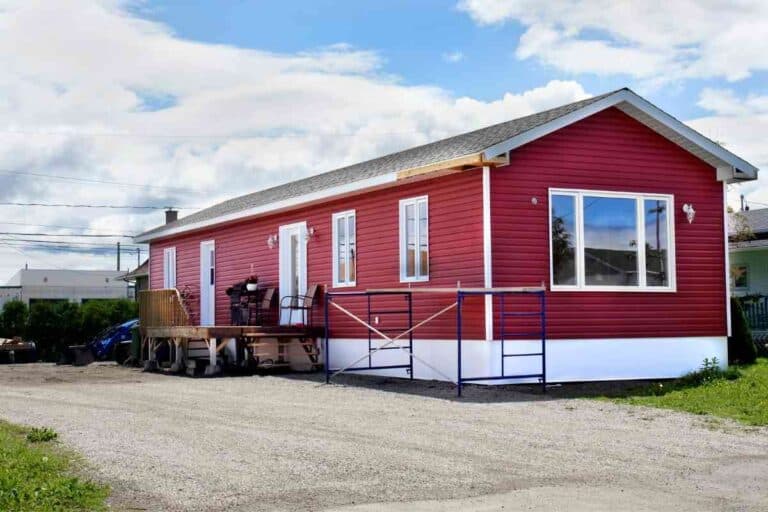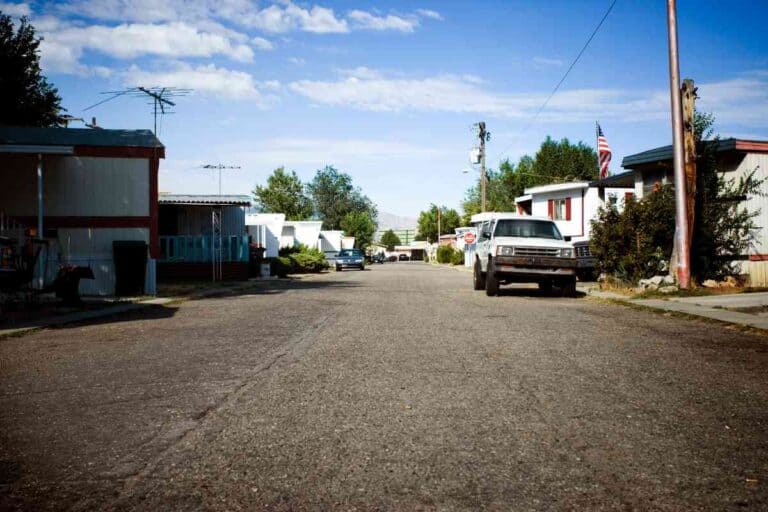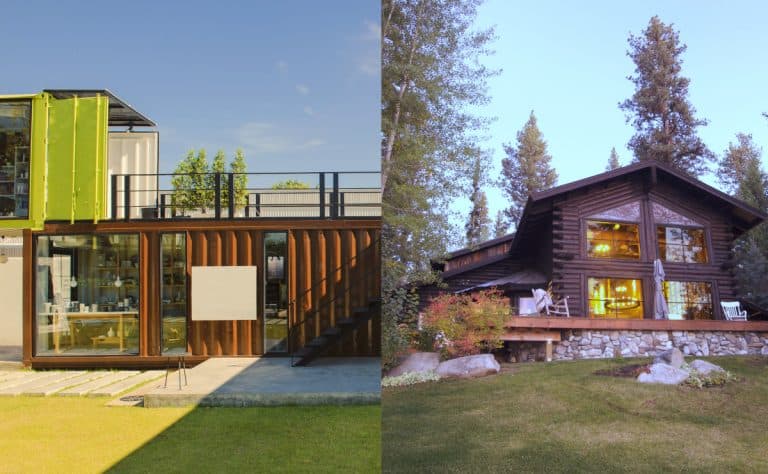Container Home vs. Mobile Home: 11 Differences That Matter
Shipping container homes are trending right now and for good reasons. Recycling an old shipping container and building a house that is specific to what you need are very attractive prospects for anyone. In a world of prefabricated, cookie-cutter homes, container homes are a breath of fresh air.
But why not just get a mobile home instead, some may ask. After all, that’s a true and tried construction method that will offer about the same as a container home, right? The answer is that they aren’t exactly comparable, even if they appear to be.
Mobile homes generally take less work to build and will last longer. Container homes offer modularity and more design freedom, but they also require more work to become liveable.
Of course, that is just the short, generalized, answer. In this article, we will dig deeper into 11 impactful differences between container homes and mobile homes that may impact your decisions.

Design Freedom
One of the biggest reasons that people choose container homes is for the freedom to build however they want. Aside from being modular (which we’ll discuss later), a container home can be configured for any purpose. You can add walls to the interior wherever you want them, you can choose where to put the bathroom, and you can define every aspect of the build.
It’s a lot of work, but it inspires freedom of choice that most mobile homes don’t.
But that’s only correct some of the time. Container homes offer a lot of freedom, but so do mobile homes. Some companies prefabricate mobile homes exactly how you want them. For a little extra money, you can completely design the interior of your mobile home as well.
The main difference when it comes to building style and freedom comes from the act of doing it yourself. Even if you hire a contractor to help, you will be drafting the plans yourself. You’ll be the sole person deciding where the walls go and where the plumbing should be.
You can purchase a shipping container from a prefab company (more on that later), but most of the time, you’ll be deciding on every aspect of your home build.
With a mobile home, you can choose a cookie-cutter floorplan, select your add-ons, and be ready to go. That simply isn’t an option that is present with shipping container homes right now.
Cost Disparity
Perhaps the most significant difference between mobile homes and shipping container homes comes with the cost. There is no way to cut corners here: both options are expensive. Neither is as costly as having a stick house built, but they still require a lot of money to get started.
But there is a major disparity between the cost of a mobile home and the cost of a shipping container home. Some people mistakenly assume that a shipping container home is going to be less expensive due to the low cost of the shipping containers themselves, but that isn’t the case at all.
| Container Home (Single Container) | Mobile Home (Single-Wide) | Permanent Residential Home | |
| Used | — | $25,000 | $295,000 |
| New | $50,000 | $51,371 | $350,000 |
The cost of a home made from a single shipping container can vary depending on how you build it. If you’re purchasing one that is already made, this is the price you’d be expected to pay – just about the same as a single-wide mobile home.
If you build it yourself, a shipping container home may require a smaller upfront investment, but it isn’t less expensive overall. The cost of the interior work, plumbing, and necessary renovation to convert the container into a home, rivals (and often exceeds) the price of a mobile home.
Modular Design
Since shipping containers are just rectangular boxes, the possibilities are endless. You can convert a singular container into a tiny home if that’s what you want, but you can also combine 8 of them to create a multi-level home with dozens of rooms if you like.

It’s all up to you. Cost is a factor to consider before you go off the deep end (as each container will need to be converted and attached if you’re using more than one). Outside of how much it will cost, however, the sky is the limit due to the container home’s modular nature.
Mobile homes are often built off-site and shipped to the location to be assembled and hooked up to utilities. Container homes, on the other hand, are delivered to your site before any work is done. You can arrange the metal boxes however you like. They are assembled, designed, and renovated on-site.
There is so much you can do with a shipping container home because they are delivered this way. You can stack them, make long hallways with attached rooms, and more. Because shipping container homes are so recently popular, there is also plenty of inspiration and ideas you can implement to create your perfect home.
Energy Efficiency
Another significant difference between mobile homes and shipping container homes has to do with energy efficiency. Many people believe that shipping containers are more eco-friendly because they are recycled, may not use as many building materials, and tend towards saving energy.
In truth, it depends on how the home is built. You can rig a container home for solar power easier than you might convert a stick home. Alternatively, you’re going to need to insulate the shipping container reasonably well if you want to conserve energy.
The importance of recycling cannot be overstated, as it’s better to use these containers than leaving them to sit around and rust. However, when it comes to energy efficiency, they are generally a lot less efficient than newer mobile homes.
Shipping containers are essentially metal boxes. It takes a lot of work to convert them correctly and to make them energy-efficient may be expensive and time-consuming. However, newer mobile homes are built to specific regulations and standards. This includes energy-efficiency as part of the building process. This assists in lower bills and better climate control with insulation, as we’ll talk about later.
Is it possible to make a shipping container well-insulated, sound, and decrease energy bills? Absolutely. But it takes a large amount of work that newer mobile homes don’t require.
Difficulty in Renovations
Say you need a home office space in the future, or you decide to have another child. You’ll need more room, and inevitably this will lead to the need for renovations.
It’s challenging to renovate both mobile homes and container homes, of course. It’s a more delicate process than it would be to renovate a stick home on a foundation. But the mobile home lends itself better to adding walls, creating rooms, and moving plumbing.
Why is that? According to Architect Mark Hogan, it has everything to do with the structure of the container itself:
“The rails at the top and the roof of the container are not structural at all (the roof of a container is light gauge steel, and will dent easily if you step on it). If you cut openings in the container walls, the entire structure starts to deflect and needs to be reinforced because the corrugated sides act like the flange of beam and once big pieces are removed, the beam stops working.”
Because a shipping container is made of corrugated metal, it needs significant reinforcement to remain structurally sound. Change anything about the original plan for your container home and you’re looking at reinforcing different areas, which can be expensive.
Mobile homes aren’t perfect for extensive renovations either, but they have the bonus of being a bit tougher. They can take a bit more before construction work before they need to be reinforced. Newer mobile homes especially are not as tricky to renovate as they once were.
Laws and Zoning Regulations
Local laws and zoning issues are one of the most considerable differences between container homes and mobile homes.
There is a certain undeserved stigma associated with mobile homes, and unfortunately, this can lead to some issues with zoning.
Some cities won’t allow single-wide mobile homes to be set up within city limits, and some relegate mobile homes to private land or mobile home parks only. This is clearly a challenge for people who wish to own a mobile home.
There is often a more positive view of container homes. There are a lot more opportunities for container homes currently, but keep in mind that local legislation may change as the popularity of container homes grows.
Laws can vary by location, so make sure that you know where you’re allowed to put a container home or mobile home. Some places there may be more places to park your container home simply because they haven’t made a law against it yet.
Lifespan
Neither mobile homes nor container homes will last for generations. Even if they are properly taken care of, the life expectancy of these types of homes is still less than a typical standard house.
- Container home life expectancy: 25 years
- Mobile home life expectancy: 30 – 55 years
- Standard residential home life expectancy: 70 – 100 years
Even though shipping containers are durable and meant to be shipped by planes, trains, and boats, they won’t last long as a home. Rust and a slow breakdown of the metal frame can lead to your shipping container home becoming obsolete within two decades. Keeping an eye on the structure is key to making sure your container home lasts more than 20 years.
Mobile homes have a slightly better life expectancy. According to HUD, manufactured mobile homes are expected to last 40 years on average. Still not a long time, but with proper care and quick repairs, your mobile home could last longer.
These are just averages, and of course, your mileage may vary. Just keep in mind that these homes types may not last long enough for your children to inherit them if you don’t keep up with maintenance.
Prefabrication Options
Here is another significant difference between container homes and mobile homes.
Mobile homes have been prefabricated for years. There are companies in just about every area that can build a mobile home precisely to your liking for a fee. This includes allowing you to choose features that you like, how you’d like the mobile home delivered, and even what cabinets and countertops will come with it.
There is a smaller market for prefabricated container homes. However, that doesn’t mean that no one is making them.
Honomobo is leading the charge when it comes to prefabricated container homes. They offer a variety of floorplans and space sizes, as well as interior color choices and upgrade options across all of the models they offer. You can get a container home built to precisely the size and scope you need.
This market for prefab container homes is limited so far. There’s a distinct lack of options with the width and breadth of some mobile home prefabrication companies, so you’ll still need to build your own container home if you want the space to be specific to your needs.
On the other hand, companies like Modular Homes can help connect you with the people and services to build an entirely custom mobile home. You can work from a floor plan, but with a mobile home from a company like this, you won’t have to.
The prefabrication options are different, but there’s no harm in working from a floor plan. In time, many more prefabrication companies for container homes are sure to arrive on the scene, giving a potential homebuyer just as many choices (if not more) than the mobile home market currently offers.
Size Differences
Shipping containers come in a variety of sizes, but the ones commonly used to build homes are 40 feet long and 8 feet wide. Once you add insulation and drywall, you have even less room to work with. Unless you put multiple shipping containers together, you’re getting a very small living space.
A single-wide mobile home is still a small living space, but it is much larger comparatively.
The good thing about these homes types is that you can choose how big you want your living space to be. There are some limits to how large mobile homes are, but there are limitless possibilities with container homes. You can put 16 of them together and create a container mansion if you like. Barring some reinforcement concerns, you have freedom.
But just one shipping container on its own is tiny. Even if you want to add on to the home later, purchasing more than one container to start with is probably a good idea.
Climate Control
You want to be cool in the summertime and warm in the winter, but that may be harder to achieve with container homes.
Older mobile homes used to suffer from a variety of climate afflictions. The roof was tin, so it attracted heat in the summer. The wall and floor were thin, so there was no insulation to keep the warmth in during the winter. HUD changed all of that when they began implementing and enforcing building standards for mobile homes.
Now, mobile homes are built with better insulation and higher building standards. It’s easy to keep them comfortable.
Shipping container homes deal with the same issues as mobile homes used to. Essentially, they are a metal box – metal attracts heat, and without a lot of insulation work, you may roast inside of them.
It can be downright dangerous to stay in a shipping container without extensive insulation modifications. If you live in areas of extreme cold or extreme heat (or states with both), you’re going to need to put forth a lot more effort to make your shipping container livable.
If you build a home with multiple levels and several containers, you also have to keep it comfortable throughout. This can present a challenge if the containers are not properly reinforced. The best HVAC system in the world can’t compete with large sheets of sun-heated metal.
More Work Required
It’s relatively easy to buy a mobile home these days. A prefabrication company can work out all the details and deliver a home outfitted with all of your upgrades and preferences without you having to do much more than sign papers. Of course, if you’re renovating a used mobile home, there is a little more work involved.
Unless you purchase a container home from a prefabrication company that specializes in making them, you’ll be doing most of the work yourself. If you’re working on a budget and don’t want to bring in a contractor, that adds up to a lot of work you’ll be doing on your own.
From converting the container to adding walls, insulation, and windows, you’ll have your work cut out for you. That just isn’t the case with a mobile home, especially one that you’ve purchased with very specific prefabrication instructions.
Understand that setting up a container home that is comfortable and safe to live in is no easy task, but all of your hard work will eventually pay off.
Conclusion
Whether you choose to live in a mobile home or purchase and renovate some shipping containers, you’re going to face some challenges.
These are the important differences that separate these types of homes from others. Keep in mind that no living arrangement is perfect, and you should choose the type of home that is best for you.






